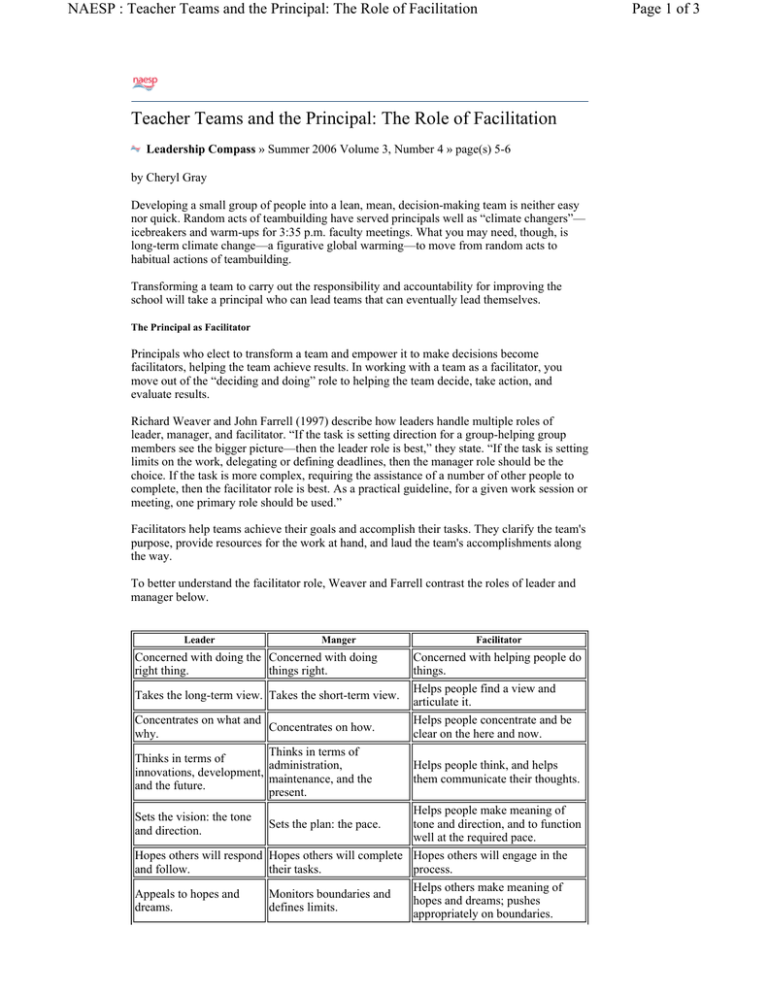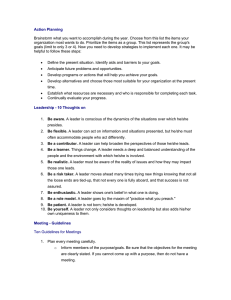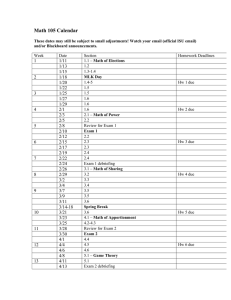Teacher Teams and the Principal: The Role of Facilitation
advertisement

NAESP : Teacher Teams and the Principal: The Role of Facilitation Teacher Teams and the Principal: The Role of Facilitation Leadership Compass » Summer 2006 Volume 3, Number 4 » page(s) 5-6 by Cheryl Gray Developing a small group of people into a lean, mean, decision-making team is neither easy nor quick. Random acts of teambuilding have served principals well as “climate changers”— icebreakers and warm-ups for 3:35 p.m. faculty meetings. What you may need, though, is long-term climate change—a figurative global warming—to move from random acts to habitual actions of teambuilding. Transforming a team to carry out the responsibility and accountability for improving the school will take a principal who can lead teams that can eventually lead themselves. The Principal as Facilitator Principals who elect to transform a team and empower it to make decisions become facilitators, helping the team achieve results. In working with a team as a facilitator, you move out of the “deciding and doing” role to helping the team decide, take action, and evaluate results. Richard Weaver and John Farrell (1997) describe how leaders handle multiple roles of leader, manager, and facilitator. “If the task is setting direction for a group-helping group members see the bigger picture—then the leader role is best,” they state. “If the task is setting limits on the work, delegating or defining deadlines, then the manager role should be the choice. If the task is more complex, requiring the assistance of a number of other people to complete, then the facilitator role is best. As a practical guideline, for a given work session or meeting, one primary role should be used.” Facilitators help teams achieve their goals and accomplish their tasks. They clarify the team's purpose, provide resources for the work at hand, and laud the team's accomplishments along the way. To better understand the facilitator role, Weaver and Farrell contrast the roles of leader and manager below. Leader Manger Concerned with doing the Concerned with doing right thing. things right. Takes the long-term view. Takes the short-term view. Concentrates on what and Concentrates on how. why. Thinks in terms of Thinks in terms of administration, innovations, development, maintenance, and the and the future. present. Facilitator Concerned with helping people do things. Helps people find a view and articulate it. Helps people concentrate and be clear on the here and now. Helps people think, and helps them communicate their thoughts. Helps people make meaning of tone and direction, and to function well at the required pace. Hopes others will respond Hopes others will complete Hopes others will engage in the and follow. their tasks. process. Helps others make meaning of Appeals to hopes and Monitors boundaries and hopes and dreams; pushes dreams. defines limits. appropriately on boundaries. Sets the vision: the tone and direction. Sets the plan: the pace. Page 1 of 3 NAESP : Teacher Teams and the Principal: The Role of Facilitation Expects others to help realize a vision. Expects others to fulfill their mission or purpose. Inspires innovation. Inspires stability. Helps others articulate a shared vision and common mission or purpose. Helps people respond to things that are new and things that remain the same. Source: Weaver & Farrell Teambuilding Activities Teambuilding activities provide a structure for the team's development. A key to teambuilding is selecting activities appropriate for the needs of team members, stages of team development, and the school culture. Here are teambuilding activities that can accomplish this: Create a team “charter.” Spend the first team meeting creating a one-page document that “charters” the team and specifies its purpose, describes how the team will function together, and determines when team members will assess how the team is functioning. You could call the charter a “Declaration of Interdependence” or other name that brings meaning to the concept of teaming. Create meeting norms. A short list of meeting behaviors should be posted or regularly listed on written agendas. To develop such meeting norms in a safe and humorous manner, spend 20 minutes of the first or second meeting having two people role-play “miserable meetings” and then have the team decide what norms would prevent this type of meeting. Recognize diverse team member roles. Each member of the team will play different roles as contributors (task-oriented), collaborators (willing to pitch in), communicators (processoriented), and challengers (questioning and encouraging risks) (Parker 1990). One effective strategy used is the Six Hats Thinking Process (De Bono 1985). Team members wear and switch one of six colorful and symbolic “hats” for comprehensively devising and discussing goals and actions: z z z z z z White is for information known or needed. Yellow symbolizes optimism and the positives. Black is for judgment, why something may not work. Red signifies feelings, hunches, and intuition. Green focuses on the possibilities and new ideas. Blue is used to manage the thinking process. Teams that use this process begin to look at decisions by wearing all of these hats. Observe and assess meetings. Effective teams assess their own processes. Assigning a team member to provide feedback on team process at the conclusion of each meeting focuses the group on living out its charter and team norms of behavior. The feedback can include such things as the balance of communication within the meeting, the attention to each task on the agenda, the ability to “parking lot” or curb distracters from the agenda, the overall meeting climate, and other aspects described in the charter and team norms. Feedback should be provided and accepted by the team without discussion. Rotating this important observer role for each meeting builds the skills of each member in recognizing effective team processes. Reflection Skills Another key to teambuilding is to reflect individually and debrief collectively from each teambuilding strategy. Reflection and team debriefing builds the capacity for organizational learning, a concept paramount to school improvement. As you facilitate the work of the team: Allow time for reflection and debriefing. Allow enough time at each meeting for thoughtful consideration, but not too much time to discuss sub-issues. Put discussion items that emerge on the next meeting’s agenda. Debriefing is for group reflection, not action. Page 2 of 3 NAESP : Teacher Teams and the Principal: The Role of Facilitation Consider introverted and extroverted personalities. Some team members will prefer individual reflection and others will prefer group debriefing; encourage both. Three common individual reflection or team debriefing questions use shapes to launch each team member’s thinking: What “squares” with my thinking? What’s still rolling around (circle) in my mind? What do we need to change (triangle for delta)? Don't deny tough issues. If the team members only focus the debriefing on the niceties, they are not engaged in hard work and do not have a trusting climate. If tough issues emerge, focus on the issue and not the persons involved. Paraphrase and ask clarifying questions to get to the essence of the concern. Encourage a balance of problem-identifying and problemsolving by putting the issue on the next meeting’s agenda for resolution. Emphasize learning together, even through failures, mistakes, and miscommunication. Be an example—inside and outside of the meeting—of listening, learning, and leading through conflict. Team learning occurs through selecting the right teambuilding activities and then reflecting and debriefing on each. Yet effective teambuilding alone is no replacement for the goal and actions of the team in changing school and classroom practices. By incorporating the role of facilitator alongside their roles as leaders and managers, principals can help teams achieve goals and accomplish more on behalf of improving student learning. References De Bono, E. Six Thinking Hats. Boston: Little Brown, 1985. Parker, G. Team Players and Teamwork: The New Competitive Business Strategy. San Francisco: Jossey-Bass: 1990. Weaver, R. and J. Farrell. Managers as Facilitators: A Practical Guide to Getting Work Done in a Changing Workplace. San Francisco: Berrett- Koehler: 1997. Cheryl Gray is with the Leadership Initiative of the Southern Regional Education Board in Atlanta. Her e-mail address is cheryl.gray@sreb.org. Leadership Compass Goes Online Look for Leadership Compass in your e-mail Inbox this fall. Beginning in September, Leadership Compass will be an electronic publication online, e-mailed to NAESP members four times a year. Make sure you receive Leadership Compass and all NAESP publications by registering on NAESP’s Web site and providing an e-mail address in your profile. Page 3 of 3

